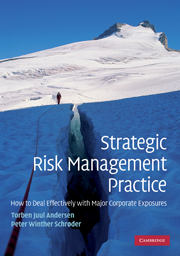Book contents
- Frontmatter
- Contents
- List of abbreviations
- List of figures
- List of tables
- List of boxes
- Preface
- 1 The strategic nature of corporate risk management
- 2 Economic exposures in corporate risk management
- 3 Managing market-related business exposures
- 4 Extending the risk management perspective
- 5 Integrative risk management perspectives
- 6 Current risk management practice and the rise of ERM
- 7 Strategic risk analyses
- 8 Strategic risk management – amendments to the ERM framework
- 9 Strategic risk management
- 10 Postscriptum
- Appendices
- Appendix 1 A strategic responsiveness model
- Appendix 2 Determining the premium on a call option
- Appendix 3 Determining the value of a real option
- Index
- References
4 - Extending the risk management perspective
Published online by Cambridge University Press: 05 June 2012
- Frontmatter
- Contents
- List of abbreviations
- List of figures
- List of tables
- List of boxes
- Preface
- 1 The strategic nature of corporate risk management
- 2 Economic exposures in corporate risk management
- 3 Managing market-related business exposures
- 4 Extending the risk management perspective
- 5 Integrative risk management perspectives
- 6 Current risk management practice and the rise of ERM
- 7 Strategic risk analyses
- 8 Strategic risk management – amendments to the ERM framework
- 9 Strategic risk management
- 10 Postscriptum
- Appendices
- Appendix 1 A strategic responsiveness model
- Appendix 2 Determining the premium on a call option
- Appendix 3 Determining the value of a real option
- Index
- References
Summary
Now the focus moves beyond conventional risk management approaches and takes the wider spectrum of risks into consideration, including commercial and strategic exposures. The focus is also extended from insurance and derivative contracts to include alternative risk-transfer mechanisms and operational flexibilities needed to cope with longer-term systemic risks and firm-specific economic exposures. There is a focused discussion of the real options logic where financial options analysis is extended to the context of option structures framed by firm-specific asset positions, dynamic capabilities and external market conditions. A framework to analyze specific business opportunities as potential responsive actions in a turbulent environment is outlined and its potential use is discussed in more detail.
Risk management in all of its aspects
The range of exposures considered in conventional risk management thinking includes various insurable hazards as well as market-related, operational and commercial risks. Insurable risks comprise a range of casualties, accidents and man-made disasters, such as fire, collisions, explosions, etc., and natural disasters caused by, for example, windstorm, flooding and earthquake events that may destroy productive assets and disrupt the production flows. Market-related risks comprise the effects of changes in various market prices, such as commodity prices, energy prices, foreign exchanges rates, interest rates and so forth, all of which have the capacity to affect corporate performance. There has been an increased focus on operational risks in recent years comprising events like processing failures, technology breakdowns, human errors, misreporting, fraud and the like.
- Type
- Chapter
- Information
- Strategic Risk Management PracticeHow to Deal Effectively with Major Corporate Exposures, pp. 76 - 98Publisher: Cambridge University PressPrint publication year: 2010

